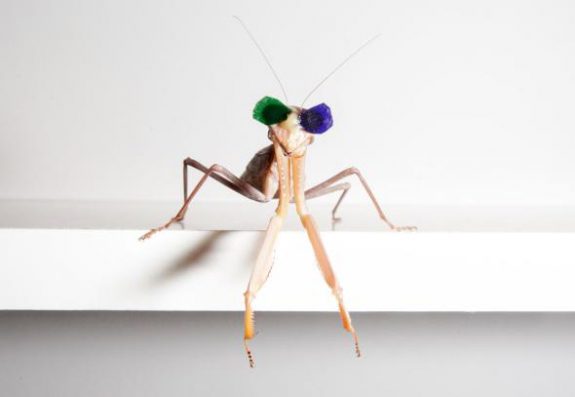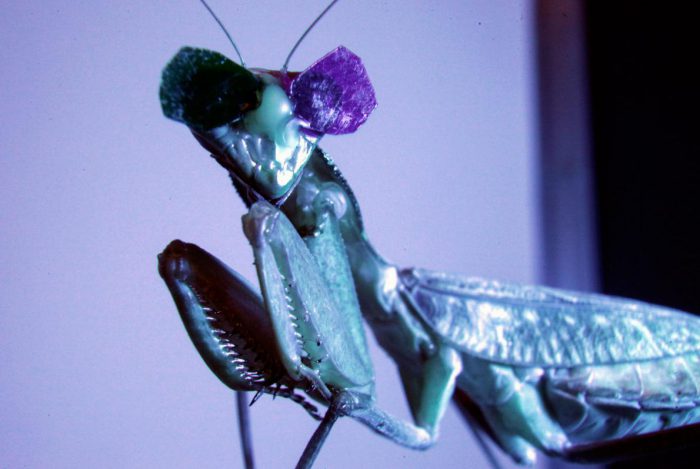Being able to see in three dimensions is a key to human life. Same for many predatory birds and mammals. Whether grabbing a glass of water or snatching prey, 3D vision (or stereopsis) is a major advantage for the animals that possess it.
Insects generally do not have 3D vision. Their compound eyes—which can have tens of thousands of lenses per eyeball—are certainly impressive at reacting to movement around them. But they're not capable of stereo vision. All except for the praying mantis, that is.
Research has confirmed that this famous predatory insect can see in 3D. And now with the help of 3D glasses, scientists are learning even more about what makes this incredible insect so special.
Glasses? On a bug?
Classic 3D glasses featured one red and one blue lens to create the illusion of 3D on a movie screen, but... (Getty Embed)

...the glasses on the mantis replaced red with green because mantises cannot see that colour very well. (Newcastle University)
Yep, you read that correctly. 3D glasses on an insect. How? Why?
Let's address the "how" first. Using beeswax (neat!), researchers at Newcastle University glued the different-coloured lenses across the bug's forehead. And bingo...you've got a mantis that is ready for the movies!
But the "why" of this situation leads to something that is truly interesting. Though scientists already knew that the mantis could see in 3D, they were curious as to how similar it was to human vision. Their experiment involved setting up a miniature movie theatre that projected 3D images of objects that looked like prey, floating in front of the mantis. Based on the insect's reaction to the projections, the researchers were able to learn much more about their vision.
Based on motion

The study suggested that mantises could even see camouflaged prey because their 3D vision is based on brightness and motion. (Kenneth Lee | Dreamstime.com)
So what are the conclusions?
Generally, stereoscopic-viewing animals (such as owls, cats, and humans), judge distance based on slight differences between the position of objects in our left and right eyes. (You can test this by staring at an object and blinking back and forth between your eyes.)
Mantis stereo eyesight is kind of different. The tests revealed that mantis eyes focus on the difference in brightness between the left and right image. To make that a little clearer, such a difference in brightness is usually caused by objects in motion. This style of vision makes sense when you consider that a mantis spends its day waiting to capture objects in motion, such as little bugs zipping around nearby!
Scientists have much more still to learn about mantis vision, but they hope that what they learn could one day be used to create 3D vision in robots. Would you look at that!
 Pass the popcorn! (Or the crickets, either way...) (Newcastle University)
Pass the popcorn! (Or the crickets, either way...) (Newcastle University)










COOOL!!